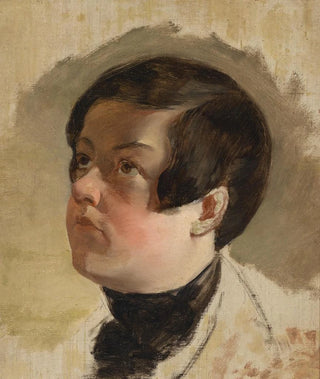Art print | Study of a boy's head - Friedrich von Amerling Source: Reproduction | Étude de la tête d'un garçon - Friedrich von Amerling


View from behind

Frame (optional)
In the fascinating world of art, some works manage to capture the very essence of humanity. "Study of a Boy's Head" by Friedrich von Amerling is a perfect example. This painting, a true ode to youth, evokes an emotional depth that transcends time. Through delicate features and the lively expression of the young boy, the artist succeeds in establishing a poignant dialogue between the viewer and the subject. This piece, imbued with sensitivity, invites reflection on innocence and the fleeting beauty of childhood.
Style and uniqueness of the work
Von Amerling's work stands out for its refined technique and attention to detail. The striking realism of "Study of a Boy's Head" demonstrates his mastery of nuances and shadows. Every brushstroke seems to be a caress on the canvas, paying homage to the fragility of youth. The boy's eyes, bright and expressive, appear to tell a story, a quest for knowledge and understanding of the world around him. The composition, both simple and profound, allows the viewer to focus on the very essence of the face, thus revealing art's ability to evoke universal emotions. The soft light bathing the young boy's face enhances this intimate atmosphere, making the piece even more captivating.
The artist and his influence
Friedrich von Amerling, an Austrian painter of the 19th century, is often celebrated for his contribution to the realism movement. Influenced by the masters of classical painting, he developed a personal style that combines technical precision and sensitivity. Amerling was also a recognized portraitist, and "Study of a Boy's Head" perfectly illustrates his talent for capturing the soul of his subjects. His work had a significant impact on his contemporaries and continues to inspire many artists today. By exploring themes of childhood and human nature, von Amerling paved the way for a deeper understanding of the individual within the societal context. His legacy endures, and every gaze cast upon his creations is an invitation to rediscover the beauty of art.

Matte finish

View from behind

Frame (optional)
In the fascinating world of art, some works manage to capture the very essence of humanity. "Study of a Boy's Head" by Friedrich von Amerling is a perfect example. This painting, a true ode to youth, evokes an emotional depth that transcends time. Through delicate features and the lively expression of the young boy, the artist succeeds in establishing a poignant dialogue between the viewer and the subject. This piece, imbued with sensitivity, invites reflection on innocence and the fleeting beauty of childhood.
Style and uniqueness of the work
Von Amerling's work stands out for its refined technique and attention to detail. The striking realism of "Study of a Boy's Head" demonstrates his mastery of nuances and shadows. Every brushstroke seems to be a caress on the canvas, paying homage to the fragility of youth. The boy's eyes, bright and expressive, appear to tell a story, a quest for knowledge and understanding of the world around him. The composition, both simple and profound, allows the viewer to focus on the very essence of the face, thus revealing art's ability to evoke universal emotions. The soft light bathing the young boy's face enhances this intimate atmosphere, making the piece even more captivating.
The artist and his influence
Friedrich von Amerling, an Austrian painter of the 19th century, is often celebrated for his contribution to the realism movement. Influenced by the masters of classical painting, he developed a personal style that combines technical precision and sensitivity. Amerling was also a recognized portraitist, and "Study of a Boy's Head" perfectly illustrates his talent for capturing the soul of his subjects. His work had a significant impact on his contemporaries and continues to inspire many artists today. By exploring themes of childhood and human nature, von Amerling paved the way for a deeper understanding of the individual within the societal context. His legacy endures, and every gaze cast upon his creations is an invitation to rediscover the beauty of art.






